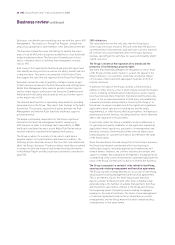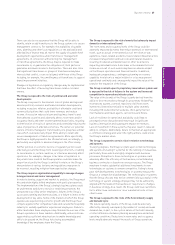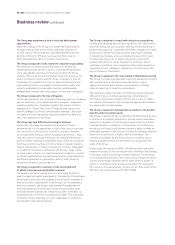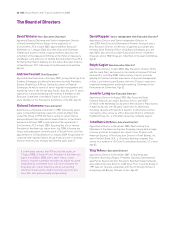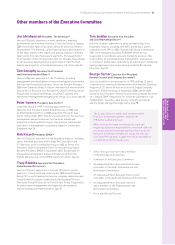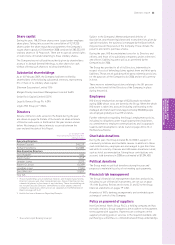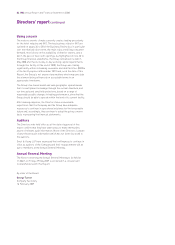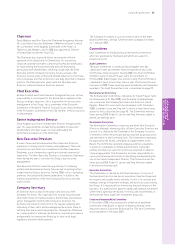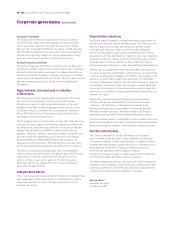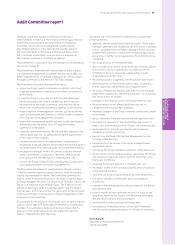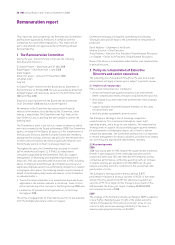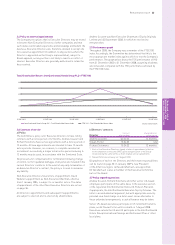Holiday Inn 2008 Annual Report Download - page 37
Download and view the complete annual report
Please find page 37 of the 2008 Holiday Inn annual report below. You can navigate through the pages in the report by either clicking on the pages listed below, or by using the keyword search tool below to find specific information within the annual report.
THE BOARD, SENIOR
MANAGEMENT AND
THEIR RESPONSIBILITIES
Corporate governance 35
Combined Code compliance
The Board is committed to compliance with the principles set
out in the Combined Code on Corporate Governance (the Code)
and considers that the Company has complied with the Code
requirements throughout the year ended 31 December 2008.
As InterContinental Hotels Group PLC’s shares are also listed on
the New York Stock Exchange (NYSE), the Company is subject to
the rules of the NYSE, US securities laws and the rules of the
Securities and Exchange Commission (SEC). As required by the
SEC, a statement outlining the differences between the Company’s
corporate governance practices and those followed by US
companies may be found on the Company’s website at
www.ihg.com/investors under corporate governance/NYSE
differences.
Control environment
The Board is responsible for the Group’s system of internal control
and risk management and for reviewing its effectiveness. In order
to discharge that responsibility, the Board has established the
procedures necessary to apply the Code, including clear operating
procedures, lines of responsibility and delegated authority.
Business performance is managed closely and, in particular,
the Board, the Executive Committee and the Regional Operating
Committees have established processes, as part of the normal
good management of the business, to monitor:
• strategic plan achievement, through a comprehensive series
of Group and regional strategic reviews;
• financial performance, within a comprehensive financial
planning and accounting framework;
• capital investment performance, with detailed appraisal
and authorisation processes; and
• risk management (through an ongoing process, which has been
in place up to the date of the accounts), providing assurance
through reports from: the Head of Risk Management; the Head
of Internal Audit; and, in certain instances, from management,
that the significant risks faced by the Group are being identified,
evaluated and appropriately managed, having regard to the
balance of risk, cost and opportunity.
In addition, the Audit Committee reviews:
• regular reports from management, Internal Audit and the
external auditor on the effectiveness of systems for internal
control, financial reporting and risk management;
• the timeliness and effectiveness of corrective action taken
by management; and
• material financial and non-financial risks.
The Board has conducted a review of the effectiveness
of the system of internal control during the year ended
31 December 2008. This covered all material controls,
including financial, operational and compliance controls,
and risk management systems, and took into account any
material developments since the year end.
The review was carried out through the monitoring process set
out above, which accords with the Turnbull Guidance. The system
of internal control is designed to manage, rather than eliminate,
the risk of failure to achieve business objectives and it must be
recognised that it can only provide reasonable and not absolute
assurance against material misstatement or loss. Whilst areas
for improvement in internal control have been identified and
actions initiated as a result of the above process, no significant
shortcomings in internal control have been identified from the
annual assessment.
To comply with the Group’s US obligations, arising from the
Sarbanes-Oxley Act 2002, a project has been completed to identify,
evaluate and test key financial controls across all our business
units. This enabled appropriate representations regarding the
effectiveness of internal financial controls to be made in the
Company’s Annual Report on Form 20-F, filed with the SEC in
March 2008, in compliance with these US obligations.
With regard to insurance against risk, it is not practicable to insure
against every risk to the fullest extent. While the insurance market
has eased in some areas, certain risks, eg natural catastrophe,
remain difficult to insure both as to breadth and cost of coverage.
In some cases external insurance is not available at all or not at
an economic price. The Group regularly reviews both the type and
amount of external insurance that it buys, bearing in mind the
availability of such cover, its price and the likelihood and magnitude
of the risks involved.
Board and Committee structure
To support the principles of good corporate governance, the Board
and Committee structure operates as set out below.
The Board
The Board’s current composition of the Non-Executive Chairman,
two Executive and five Non-Executive Directors meets the
requirement of the Combined Code for at least half the Board,
excluding the Chairman, to be independent Non-Executive
Directors. In the Board’s view, all of the current Non-Executive
Directors are independent.
The Board is responsible to the shareholders for the strategic
direction, development, performance and control of the Group.
It therefore approves strategic plans and capital and revenue
budgets. It reviews significant investment proposals and the
performance of past investments and maintains an overview
and control of the Group’s operating and financial performance.
It monitors the Group’s overall system of internal controls,
governance and compliance. The Board ensures that the necessary
financial and human resources are in place for the Group to meet
its objectives. The Board has established a schedule of matters
which are reserved for its attention and decision. These may be
found on the Company’s website.
The Board adopts objective criteria for the appointment of
Directors, and the roles of the Chairman and of the Chief Executive
have been defined in writing and approved by the Board.
Corporate governance



